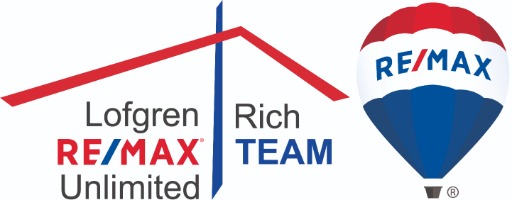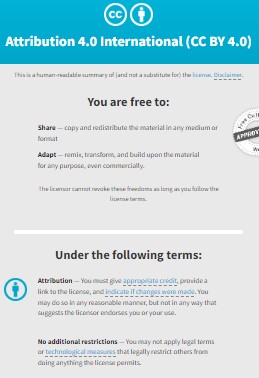Free License for Free Stuff
When I was in 6th grade, a boy named Anthony noticed my brilliant doodling of horses. He asked me to draw a picture of woman in a bathing suit. I had never tried it, but I discovered it was surprisingly similar to drawing horses. I handed over my first commissioned piece of art. He promptly erased the bathing suit and replaced it with body parts. It floated around the room. The teacher confiscated it. Everyone pointed at Anthony, who pointed at me.
“She drew it.”
The teacher gasped. “Amy! Did you draw this?”
I pleaded my case to no avail. I literally got a spanking in the hallway for drawing an illicit picture. Wow. I just realized my definition of paddle board has come a long way. So has in-school discipline. So has copyright.
If I knew then what I know now, I would have applied a CC BY license to my sketch for Anthony. He would have been legally obligated to admit he modified my work. Phfsh! Let’s grow up now.
Well, I am grown up now, and I have no business judging Anthony. I did the same thing to that sub at the top of this article. I bet that photographer never dreamed his sandwich would be desecrated with barcodes and icons.
How would you feel? Let’s say you capture the most fabulous video of your baby’s snot bubbles. You post it online and it goes viral. Would you like more control over what happens to it? Creative Commons can help. But what is this CC BY license I speak of? That is the primary free license package offered by Creative Commons. This lesson will explain what these licenses are made of, and our choices to use them.
CC License Recipe
Ingredients
1 CC BY Attribution deed
1 human-readable summary
1 machine-readable metadata
1 CC website notice
1 CC license icon
Optional caveats
CC SA ShareAlike deed
CC ND NoDerivatives deed
CC NC NonCommercial deed
Directions
- Add a creator name and creation title to the CC BY Attribution deed.
- Add any optional deeds.
- Layer a human-readable summary on top of the legal code.
- Layer machine-readable metadata on top of the human-readable summary.
- Install a notice on the website where your creation appears.
- Share and enjoy.
Layers of a CC License
Do you have a license for anything? Does it have different faces for different occasions? For example, my driver license travels with me on a plastic card with a few details. But that card does not list all of my rights and responsibilities as a driver. Those are written in some legal code in some long government document that nobody ever reads unless a dispute arises.
Likewise, CC licenses come with three different views: one for internet machines, one for humans, and one for… well, lawyers.
Creative Commons likes to call these views “layers”. Here’s a graphical depiction from CC’s excellent certification course.
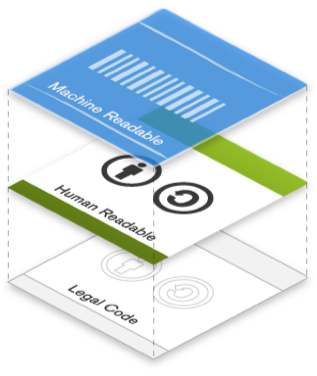
Can you see us humans squeezed in between the machines and lawyers? It’s a fact. We co-exist with machines and lawyers. Why do you suppose Creative Commons chose to arrange them in this order? Let’s take a look at these layers.
CC BY Attribution Legal Code
The foundation of a CC license is the legal code on the Creative Commons website. It was written by lawyers, for lawyers. This code is legally binding and enforceable in court, even if you don’t display it all on your web page or artwork. Here, you can read it. I’ll wait.
Creative Commons Attribution 4.0 International Public License
By exercising the Licensed Rights (defined below), You accept and agree to be bound by the terms and conditions of this Creative Commons Attribution 4.0 International Public License (“Public License”). To the extent this Public License may be interpreted as a contract, You are granted the Licensed Rights in consideration of Your acceptance of these terms and conditions, and the Licensor grants You such rights in consideration of benefits the Licensor receives from making the Licensed Material available under these terms and conditions.
Section 1 – Definitions.
- Adapted Material means material subject to Copyright and Similar Rights that is derived from or based upon the Licensed Material and in which the Licensed Material is translated, altered, arranged, transformed, or otherwise modified in a manner requiring permission under the Copyright and Similar Rights held by the Licensor. For purposes of this Public License, where the Licensed Material is a musical work, performance, or sound recording, Adapted Material is always produced where the Licensed Material is synched in timed relation with a moving image.
- Adapter’s License means the license You apply to Your Copyright and Similar Rights in Your contributions to Adapted Material in accordance with the terms and conditions of this Public License.
- Copyright and Similar Rights means copyright and/or similar rights closely related to copyright including, without limitation, performance, broadcast, sound recording, and Sui Generis Database Rights, without regard to how the rights are labeled or categorized. For purposes of this Public License, the rights specified in Section 2(b)(1)-(2) are not Copyright and Similar Rights.
- Effective Technological Measures means those measures that, in the absence of proper authority, may not be circumvented under laws fulfilling obligations under Article 11 of the WIPO Copyright Treaty adopted on December 20, 1996, and/or similar international agreements.
- Exceptions and Limitations means fair use, fair dealing, and/or any other exception or limitation to Copyright and Similar Rights that applies to Your use of the Licensed Material.
- Licensed Material means the artistic or literary work, database, or other material to which the Licensor applied this Public License.
- Licensed Rights means the rights granted to You subject to the terms and conditions of this Public License, which are limited to all Copyright and Similar Rights that apply to Your use of the Licensed Material and that the Licensor has authority to license.
- Licensor means the individual(s) or entity(ies) granting rights under this Public License.
- Share means to provide material to the public by any means or process that requires permission under the Licensed Rights, such as reproduction, public display, public performance, distribution, dissemination, communication, or importation, and to make material available to the public including in ways that members of the public may access the material from a place and at a time individually chosen by them.
- Sui Generis Database Rights means rights other than copyright resulting from Directive 96/9/EC of the European Parliament and of the Council of 11 March 1996 on the legal protection of databases, as amended and/or succeeded, as well as other essentially equivalent rights anywhere in the world.
- You means the individual or entity exercising the Licensed Rights under this Public License. Your has a corresponding meaning.
Section 2 – Scope.
- License grant.
- Subject to the terms and conditions of this Public License, the Licensor hereby grants You a worldwide, royalty-free, non-sublicensable, non-exclusive, irrevocable license to exercise the Licensed Rights in the Licensed Material to:
- reproduce and Share the Licensed Material, in whole or in part; and
- produce, reproduce, and Share Adapted Material.
- Exceptions and Limitations. For the avoidance of doubt, where Exceptions and Limitations apply to Your use, this Public License does not apply, and You do not need to comply with its terms and conditions.
- Term. The term of this Public License is specified in Section 6(a).
- Media and formats; technical modifications allowed. The Licensor authorizes You to exercise the Licensed Rights in all media and formats whether now known or hereafter created, and to make technical modifications necessary to do so. The Licensor waives and/or agrees not to assert any right or authority to forbid You from making technical modifications necessary to exercise the Licensed Rights, including technical modifications necessary to circumvent Effective Technological Measures. For purposes of this Public License, simply making modifications authorized by this Section 2(a)(4) never produces Adapted Material.
- Downstream recipients.
- Offer from the Licensor – Licensed Material. Every recipient of the Licensed Material automatically receives an offer from the Licensor to exercise the Licensed Rights under the terms and conditions of this Public License.
- No downstream restrictions. You may not offer or impose any additional or different terms or conditions on, or apply any Effective Technological Measures to, the Licensed Material if doing so restricts exercise of the Licensed Rights by any recipient of the Licensed Material.
- No endorsement. Nothing in this Public License constitutes or may be construed as permission to assert or imply that You are, or that Your use of the Licensed Material is, connected with, or sponsored, endorsed, or granted official status by, the Licensor or others designated to receive attribution as provided in Section 3(a)(1)(A)(i).
- Subject to the terms and conditions of this Public License, the Licensor hereby grants You a worldwide, royalty-free, non-sublicensable, non-exclusive, irrevocable license to exercise the Licensed Rights in the Licensed Material to:
- Other rights.
- Moral rights, such as the right of integrity, are not licensed under this Public License, nor are publicity, privacy, and/or other similar personality rights; however, to the extent possible, the Licensor waives and/or agrees not to assert any such rights held by the Licensor to the limited extent necessary to allow You to exercise the Licensed Rights, but not otherwise.
- Patent and trademark rights are not licensed under this Public License.
- To the extent possible, the Licensor waives any right to collect royalties from You for the exercise of the Licensed Rights, whether directly or through a collecting society under any voluntary or waivable statutory or compulsory licensing scheme. In all other cases the Licensor expressly reserves any right to collect such royalties.
Section 3 – License Conditions.
Your exercise of the Licensed Rights is expressly made subject to the following conditions.
- Attribution.
- If You Share the Licensed Material (including in modified form), You must:
- retain the following if it is supplied by the Licensor with the Licensed Material:
- identification of the creator(s) of the Licensed Material and any others designated to receive attribution, in any reasonable manner requested by the Licensor (including by pseudonym if designated);
- a copyright notice;
- a notice that refers to this Public License;
- a notice that refers to the disclaimer of warranties;
- a URI or hyperlink to the Licensed Material to the extent reasonably practicable;
- indicate if You modified the Licensed Material and retain an indication of any previous modifications; and
- indicate the Licensed Material is licensed under this Public License, and include the text of, or the URI or hyperlink to, this Public License.
- retain the following if it is supplied by the Licensor with the Licensed Material:
- You may satisfy the conditions in Section 3(a)(1) in any reasonable manner based on the medium, means, and context in which You Share the Licensed Material. For example, it may be reasonable to satisfy the conditions by providing a URI or hyperlink to a resource that includes the required information.
- If requested by the Licensor, You must remove any of the information required by Section 3(a)(1)(A) to the extent reasonably practicable.
- If You Share Adapted Material You produce, the Adapter’s License You apply must not prevent recipients of the Adapted Material from complying with this Public License.
- If You Share the Licensed Material (including in modified form), You must:
Section 4 – Sui Generis Database Rights.
Where the Licensed Rights include Sui Generis Database Rights that apply to Your use of the Licensed Material:
- for the avoidance of doubt, Section 2(a)(1) grants You the right to extract, reuse, reproduce, and Share all or a substantial portion of the contents of the database;
- if You include all or a substantial portion of the database contents in a database in which You have Sui Generis Database Rights, then the database in which You have Sui Generis Database Rights (but not its individual contents) is Adapted Material; and
- You must comply with the conditions in Section 3(a) if You Share all or a substantial portion of the contents of the database.
For the avoidance of doubt, this Section 4 supplements and does not replace Your obligations under this Public License where the Licensed Rights include other Copyright and Similar Rights.
Section 5 – Disclaimer of Warranties and Limitation of Liability.
- Unless otherwise separately undertaken by the Licensor, to the extent possible, the Licensor offers the Licensed Material as-is and as-available, and makes no representations or warranties of any kind concerning the Licensed Material, whether express, implied, statutory, or other. This includes, without limitation, warranties of title, merchantability, fitness for a particular purpose, non-infringement, absence of latent or other defects, accuracy, or the presence or absence of errors, whether or not known or discoverable. Where disclaimers of warranties are not allowed in full or in part, this disclaimer may not apply to You.
- To the extent possible, in no event will the Licensor be liable to You on any legal theory (including, without limitation, negligence) or otherwise for any direct, special, indirect, incidental, consequential, punitive, exemplary, or other losses, costs, expenses, or damages arising out of this Public License or use of the Licensed Material, even if the Licensor has been advised of the possibility of such losses, costs, expenses, or damages. Where a limitation of liability is not allowed in full or in part, this limitation may not apply to You.
- The disclaimer of warranties and limitation of liability provided above shall be interpreted in a manner that, to the extent possible, most closely approximates an absolute disclaimer and waiver of all liability.
Section 6 – Term and Termination.
- This Public License applies for the term of the Copyright and Similar Rights licensed here. However, if You fail to comply with this Public License, then Your rights under this Public License terminate automatically.
- Where Your right to use the Licensed Material has terminated under Section 6(a), it reinstates:
- automatically as of the date the violation is cured, provided it is cured within 30 days of Your discovery of the violation; or
- upon express reinstatement by the Licensor.
For the avoidance of doubt, this Section 6(b) does not affect any right the Licensor may have to seek remedies for Your violations of this Public License.
- For the avoidance of doubt, the Licensor may also offer the Licensed Material under separate terms or conditions or stop distributing the Licensed Material at any time; however, doing so will not terminate this Public License.
- Sections 1, 5, 6, 7, and 8 survive termination of this Public License.
Section 7 – Other Terms and Conditions.
- The Licensor shall not be bound by any additional or different terms or conditions communicated by You unless expressly agreed.
- Any arrangements, understandings, or agreements regarding the Licensed Material not stated herein are separate from and independent of the terms and conditions of this Public License.
Section 8 – Interpretation.
- For the avoidance of doubt, this Public License does not, and shall not be interpreted to, reduce, limit, restrict, or impose conditions on any use of the Licensed Material that could lawfully be made without permission under this Public License.
- To the extent possible, if any provision of this Public License is deemed unenforceable, it shall be automatically reformed to the minimum extent necessary to make it enforceable. If the provision cannot be reformed, it shall be severed from this Public License without affecting the enforceability of the remaining terms and conditions.
- No term or condition of this Public License will be waived and no failure to comply consented to unless expressly agreed to by the Licensor.
- Nothing in this Public License constitutes or may be interpreted as a limitation upon, or waiver of, any privileges and immunities that apply to the Licensor or You, including from the legal processes of any jurisdiction or authority.
Creative Commons is not a party to its public licenses. Notwithstanding, Creative Commons may elect to apply one of its public licenses to material it publishes and in those instances will be considered the “Licensor.” The text of the Creative Commons public licenses is dedicated to the public domain under the CC0 Public Domain Dedication. Except for the limited purpose of indicating that material is shared under a Creative Commons public license or as otherwise permitted by the Creative Commons policies published at creativecommons.org/policies, Creative Commons does not authorize the use of the trademark “Creative Commons” or any other trademark or logo of Creative Commons without its prior written consent including, without limitation, in connection with any unauthorized modifications to any of its public licenses or any other arrangements, understandings, or agreements concerning use of licensed material. For the avoidance of doubt, this paragraph does not form part of the public licenses.
Creative Commons may be contacted at creativecommons.org.
Additional languages available: العربية, čeština, Deutsch, Ελληνικά, Español, euskara, suomeksi, français, hrvatski, Bahasa Indonesia, italiano, 日本語, 한국어, Lietuvių, latviski, te reo Māori, Nederlands, norsk, polski, português, română, русский, Slovenščina, svenska, Türkçe, українська, 中文, 華語. Please read the FAQ for more information about official translations.
Human-readable summary
Machine-readable metadata
<a rel=”license” href=”http://creativecommons.org/licenses/by/4.0/”><img alt=”Creative Commons License” style=”border-width:0″ src=”https://i.creativecommons.org/l/by/4.0/88×31.png” /></a><br /><span xmlns:dct=”http://purl.org/dc/terms/” property=”dct:title”>”Creative Commons Menu”</span> by <a xmlns:cc=”http://creativecommons.org/ns#” href=”https://paperlesspontevedra.com/creative-commons-menu” property=”cc:attributionName” rel=”cc:attributionURL”>Amy Howard</a> is licensed under a <a rel=”license” href=”http://creativecommons.org/licenses/by/4.0/”>Creative Commons Attribution 4.0 International License</a>.<br />Based on a work at <a xmlns:dct=”http://purl.org/dc/terms/” href=”https://paperlesspontevedra.com/creative-commons-menu” rel=”dct:source”>https://paperlesspontevedra.com/creative-commons-menu</a>.
If you are a web creator, you might recognize some of the HTML. You might be scratching your head at some of it. This code includes CC Rights Expression Language (CC REL). We might not understand it, but Google, Wikimedia, and other software can read it — if it’s attached! Go to Google’s Advanced Search page (google.com/advanced_search) and you can filter your search to free stuff. This is possible with CC REL in the metadata.
Which is the base layer of every CC license?
Are you sure about that?
[/dsm_flipbox_child][/dsm_flipbox]
Are you sure about that?
[/dsm_flipbox_child][/dsm_flipbox]
CC Website Notice

"Creative Commons Menu" by Amy Howard is licensed under a Creative Commons Attribution 4.0 International License.
Based on a work at https://paperlesspontevedra.com/creative-commons-menu.
Optional Caveats – Commons Deeds
CC BY Attribution
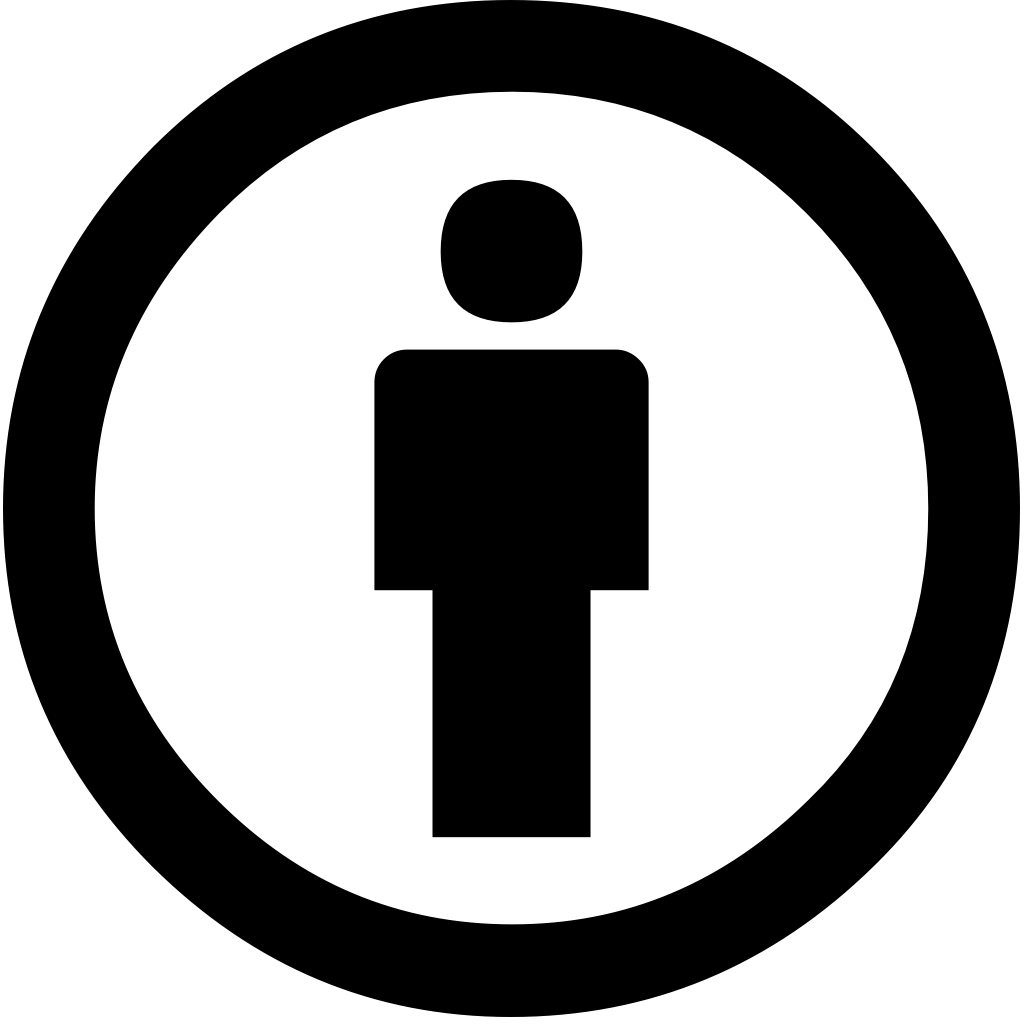
Do you recognize this person? It’s you! Or me. Or whoever is declaring a CC license. BY Attribution is the core deed of every CC license.
In fact, this option is not optional. You can’t declare a CC license without declaring your copyright authority to do so. I mean, how could anybody claim they have permission to copy from nobody?
CC BY-SA ShareAlike

Isn’t this the cutest symbol? It’s copyright’s cousin, “copyleft”. The term was coined back in the 1970s by a software developer. He got upset when he freely shared a program he wrote, then a tech giant modified it and wouldn’t let him see the modified code.
Let’s say you shared that video of your baby blowing snot bubbles. You shared it freely so it would go viral. Gosh. You sure wish Pookie wasn’t wearing that grimey shirt. But then someone else touched up the video. They made the shirt look sparkly new and blurred out the mess in the background. THAT’S the video you want to spread around. But lo and behold, the crafty videologist slapped a copyright lock on their version of your video!
Does that even matter? You still have your home-made copy, freely shared and all. If it does matter, you could add the SA ShareAlike deed to your CC license. Then all copiers are legally bound to apply the exact same CC license to whatever they make with your video. However, if they want to use it for a magazine cover that will be copyrighted, then they can’t use your baby.
CC BY-NC NonCommercial
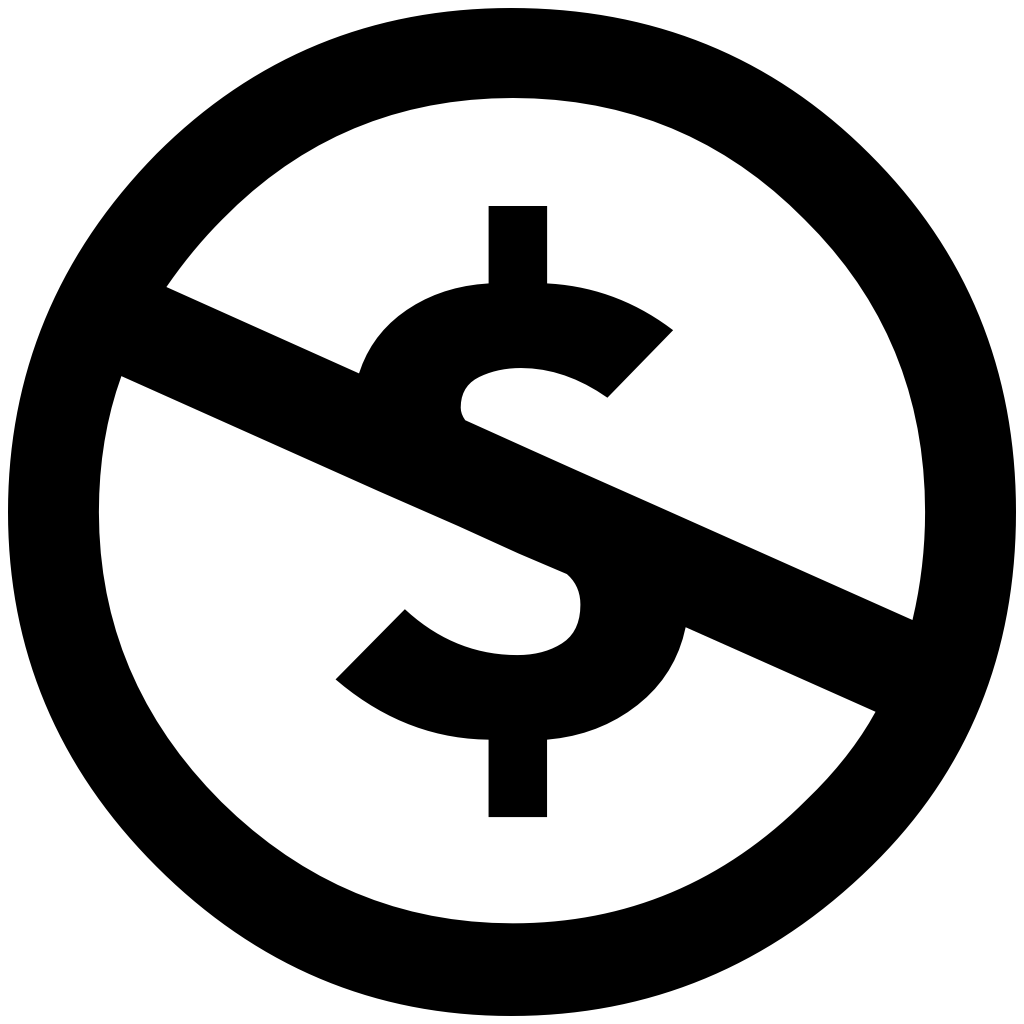
I bet you don’t need any explanation for this one. You share the most fabulous video of your baby’s snot bubbles, then you see a meme of it for sale on t-shirts and coffee mugs. In fact, you have to pay someone else, just to wear your own meme! And while you sip coffee from the snot-bubble mug, you grumble that someone else stole your fortune.
OR…
You grin ear-to-ear, knowing that you are the famous, attributed creator of this best seller on Amazon.
OR…
You somehow make it obvious that you will allow commercial use of your meme as long as you get a piece of the fortune.
In any case, the CC NC (NonCommercial) deed will tell entrepreneurs that they can’t use your creation to make money.
CC BY-ND NoDerivatives

Here’s another scenario. You’re happy that some bright entrepreneur got your baby’s picture onto purchasable products. Then you’re pleased to see that buyers can add their own captions. Then you’re mortified to see offensive captions applied to your baby’s picture.
The CC ND NoDerivatives deed would prevent that. With this license, entrepreneurs could mass market your original video, but only an exact equivalent. This sounds nice in theory, but think about it. They could not legally reproduce the clean-shirt version. They probably would never see it in the first place because their search engine would filter out all NoDerivatives.
Ah… the world is complicated. We’d love to see our shared creation blossom with other people’s new ideas, until we don’t like their ideas. Which side of the fence is better for us? Which side is better for the world? Who came up with all those variations of the smiley face? What if copyright had aborted those little guys who define our very emotions?
This is a tough question. Do you know how many of our world’s beloved creations are actually just improvements on some earlier rendition? Maybe ALL of them! If we try to block derivatives of our work, we’ll never be part of the cycle of innovation.
Frown. I don’t like tough questions. Moving on.
The Commons Deeds
Now that you’ve imagined some potential reasons for the CC license options, you can appreciate the human-readable summary of them. Creative Commons calls these “commons deeds”. Click on each icon to see what your borrowers will see if you include these deeds in your CC license.
Which deed is included in every CC license?
Are you sure about that?
[/dsm_flipbox_child][/dsm_flipbox]
Are you sure about that?
[/dsm_flipbox_child][/dsm_flipbox]
Are you sure about that?
[/dsm_flipbox_child][/dsm_flipbox]
The Menu of Creative Commons licenses
Now that you’ve seen the optional ingredients, you can mix and match them into the various CC licenses. Here is the promised menu:

CC BY
Attribution license
- Use it freely with one rule
- Credit the creator

CC BY SA
Attribution-ShareAlike license
- Use it freely with two rules
- Credit the creator
- Apply the same CC license

CC BY NC
Attribution-NonCommercial license
- Use it freely with two rules
- Credit the creator
- NOT to make money

CC BY NC SA
Attribution-NonCommercial-ShareAlike license
- Use it freely with three rules
- Credit the creator
- NOT to make money
- Apply the same CC license

CC BY ND
Attribution-NoDerivatives license
- Use it freely with two rules
- Credit the creator
- Exact copy only

CC BY NC ND
Attribution-NonCommercial-NoDerivatives
- Use it freely with three rules
- Credit the creator
- NOT to make money
- Exact copy only
Are you in the process of creating something with borrowed creations? Are you in the process of sharing your own creation? Can you think of scenarios that each of these licenses would allow and prevent?
Which CC license is most restrictive?
Are you sure about that?
[/dsm_flipbox_child][/dsm_flipbox]
Are you sure about that?
[/dsm_flipbox_child][/dsm_flipbox]
Public Domain
Are you exhausted by all these rules and painful decisions? Did you know there is a totally free dimension of totally free creations? We don’t even have to credit the creator for them. This dimension is called the “public domain”.
To be clear, all artistic and literary creations are automatically copyrighted to their creator the moment they are recorded on something tangible (except those created for employers). But that copyright has a life span. There is a moment when human creators lose legal rights to control copies of their own creations. It varies in different countries, but in the U.S. and U.K., that moment is 70 years after the creator dies. Unless some beneficiary manages to extend the copyright, the creation is released to the world as free as the clouds.
But how would we recognize it? Do we have to be a copyright specialist?
Once again, Creative Commons has interceded for us. They created two non-license tools to label creations that are in the public domain. One of those tools is simply a sticker that flags things as public domain, including all those expired copyrights from generations past. The other is a tool that allows living creators to dedicate their creation to the public domain.
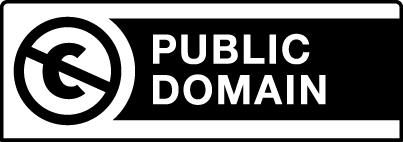
Public Domain Mark
Have you ever seen a copyright symbol crossed out? Many galleries, libraries, archivists, and museums (GLAM institutions) apply this “Public Domain Mark” to creations that are no longer copyrighted by anybody. It’s not a license; it means no license is needed.

CC 0 (Zero)
Creative Commons’ Public Domain Dedication Tool generates a declaration called CC0 (Zero). It grants total freedom for people who want to re-use our creations. It eliminates all those tough decisions and attribution requirements. And it does this with the same three layers as the licenses: legal code for lawyers, summary for humans, and metadata for search engines.
Unfortunately, CC0 is not always clear. There are special situations and special countries that do not allow people to completely abandon their creations. There are also some display institutions that use the CC0 declaration to disclaim their own copyrights to items they display, even though those items are still copyrighted by their creators. Check out Creative Commons’ explanation on this page.
Which of these means a living person dedicated their creation to the public domain?
Are you sure about that?
[/dsm_flipbox_child][/dsm_flipbox]
Are you sure about that?
[/dsm_flipbox_child][/dsm_flipbox]
CC Only Works With Copyright
One of the best parts of teaching is when adolescent students surprise me with their foresight. Just when you think you’ve drowned them with too much information, they ask about the gaps. Right about now, Sasha would ask, “What if…?”
That’s a great question! What what if? They almost all boil down to copyright. CC licenses only allow you to grant privileges that you personally control by copyright law.
“What about that spanking you got for the modified lady picture? Will I get in trouble if someone does something bad with something I dedicated to the public domain?”
“Not if your original copy is innocent. CC licenses release you from other people’s re-use of your work.”
“What if I want to modify someone’s NoDerivative for my school project?”
“That’s fine. Copyright allows Fair Use exceptions for educational purposes. Actually, copyright exceptions are a fascinating testament to the governing ideals of our country. Check them out here. Creative Commons will never restrict what copyright allows.”
“Can I dub a rap song over your NoDerivatives snot bubble video and give it to my girlfriend for Valentine’s Day?”
“Yep. That’s private use. Creative Commons will never restrict what copyright allows.”
“Can I copy-protect my gaming trademark with a CC NonCommercial license?”
“Nope. Trademarks are not protected by copyright. Go here to learn about trademarks. Creative Commons will never restrict what copyright allows.”
“Can I dedicate my embarrassing picture of Miss Clancy to the public domain?”
“Yep. And then you can pay restitution when she sues you for privacy violation. Copyright doesn’t address privacy rights. Creative Commons can’t help you there.”
“Can I apply a CC BY license to my movie quotes database, so users can only use it if they give me attribution?”
“Depends on the copyright law where you live. Yes in the U.K. No in the U.S. Creative Commons will never restrict what copyright law allows.”
“Do I have to attribute every one of the movie quotes in my database?”
“Nope. Phrases are not copyrightable. Creative Commons only covers what copyright covers.”
“Can I CC license the graphics I make for my company?”
“Nope. That’s a copyright exception. If your company paid you to make them, they belong to the company. If you don’t have copyright, you don’t have CC license rights.”
“What if I let Jorge use my song in his video and he wants to use a different CC license than me?”
“His license applies to his video. Your license applies to your song. Re-users will have to honor them separately.”
“What about that copyleft guy who wrote the software then couldn’t see the modified version? I wrote a program. Can I share it with a CC BY SA license?”
OH! Now we’ve hit a special case.
CC Licenses Are Not Fit for Sharing Software
If you have coded your own home-made computer program, you probably want to share it with others. If you want to totally be rid of it, you can use CC0 to dedicate it to the programmers of the world.
However, if you want to retain your copyright and share it, you shouldn’t use a CC license. They do not cover the particulars that are involved with design, source code, borrowed snippets, and integrations.
This is a good thing. The open-source software community is strong and sophisticated. It already has specific software license options that best navigate the open-source system. Check out the Open Source Initiative here.
How do CC licenses affect copyright exceptions?
Are you sure about that?
[/dsm_flipbox_child][/dsm_flipbox]
Are you sure about that?
[/dsm_flipbox_child][/dsm_flipbox]
Congratulations!
If you made it through this entire article, you’ve done great work. Do you have any suggestions for making this tutorial better? Do you have a question on this subject? Let’s tackle it in the discussion below. Otherwise, I hope to see you in another tutorial.
Thanks for visiting.
~Amy

